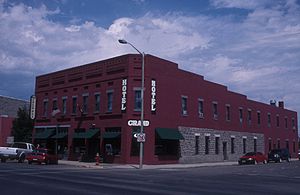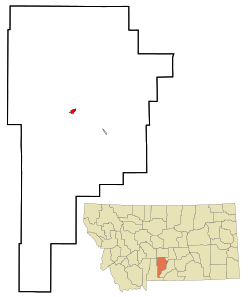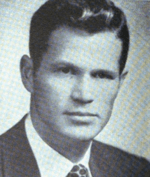Big Timber, Montana facts for kids
Quick facts for kids
Big Timber
|
|
|---|---|

Grand Hotel
|
|

Location of Big Timber, Montana
|
|
| Country | United States |
| State | Montana |
| County | Sweet Grass |
| Government | |
| • Type | Mayor Council |
| Area | |
| • Total | 0.95 sq mi (2.47 km2) |
| • Land | 0.95 sq mi (2.47 km2) |
| • Water | 0.00 sq mi (0.00 km2) |
| Elevation | 4,091 ft (1,247 m) |
| Population
(2020)
|
|
| • Total | 1,650 |
| • Density | 1,736.84/sq mi (668.02/km2) |
| Time zone | UTC−7 (Mountain (MST)) |
| • Summer (DST) | UTC−6 (MDT) |
| ZIP code |
59011
|
| Area code(s) | 406 Exchange: 932 |
| FIPS code | 30-06475 |
| GNIS feature ID | 0802032 |
Big Timber is a city in, and the county seat of Sweet Grass County, Montana, United States. The population was 1,650 at the 2020 census.
Big Timber takes its name from Big Timber Creek, which was named by William Clark because of the large cottonwood trees. The post office was established in 1880, closed, then reopened in 1882 with Ella Burns as postmaster. As a stop on the Northern Pacific Railroad, Big Timber became a major wool-shipping depot. It became the county seat in 1895. A fire in 1908 destroyed half the commercial buildings and a third of the residential homes.
Contents
Geography
Big Timber is located at 45°50′0″N 109°57′1″W / 45.83333°N 109.95028°W (45.833224, -109.950361).
According to the United States Census Bureau, the city has a total area of 0.95 square miles (2.46 km2), of which, 0.92 square miles (2.38 km2) is land and 0.03 square miles (0.08 km2) is water.
Climate
Big Timber has a cool semi-arid climate (Köppen BSk) bordering on a humid continental climate (Dfb). Although winters can be frigid, frequent chinook winds will raise temperatures above 50 °F or 10 °C on an average twenty days between December and February, and have raised them to or above 68 °F or 20 °C on ten occasions during these months since 1894. The chinooks mean Big Timber’s 31.3 days per year failing to top freezing is among the fewest in Montana, with the average window for such maxima being from November 11 to March 18. In the absence of chinooks, temperatures fall to 0 °F or −17.8 °C on seventeen mornings during an average winter, although such temperatures were reached just once in 1999/2000 but as many as thirty-four times during the very cold winters of 1935/1936 and 1978/1979. The average window for zero temperatures is from December 4 to February 25. The coldest temperature in Big Timber has been −47 °F (−43.9 °C) during the notorious 1936 cold wave on February 15, whilst February 1936 was also the coldest month on record at 5.0 °F or −15.0 °C, shading January 1916 which averaged 5.5 °F or −14.7 °C.
Spring is typically windy with temperatures nearly so variable as in winter: the last frost typically arrives on May 19, but temperatures have reached 80 °F or 26.7 °C as early as March 22 of 1928 and have fallen to zero Fahrenheit as late as April 13, 1928 and April 12, 1997. Late in spring thunderstorms increase in frequency and during late spring and early summer these provide most of Big Timber’s annual precipitation. The wettest calendar year since 1894 has been 1957 with 25.71 inches (653.0 mm) and the driest 1939 with 9.38 inches (238.3 mm), whilst the wettest single month has been May 1981 with 7.69 inches (195.3 mm)
During the summer, days can be very hot, with maxima of 90 °F or 32.2 °C on 28.5 afternoons and over 100 °F or 37.8 °C on 1.1, although mornings very rarely stay above 65 °F or 18.3 °C. The record hottest temperature is 110 °F (43.3 °C) on July 21, 1931 and the hottest morning 73 °F (22.8 °C) on July 31 of 1936.
The fall season is usually short and variable, with snow occasionally falling in September, but at other times hot weather can extend into October or even November.
| Climate data for Big Timber, Montana (1971-2000); extremes since 1894 | |||||||||||||
|---|---|---|---|---|---|---|---|---|---|---|---|---|---|
| Month | Jan | Feb | Mar | Apr | May | Jun | Jul | Aug | Sep | Oct | Nov | Dec | Year |
| Record high °F (°C) | 78 (26) |
72 (22) |
80 (27) |
89 (32) |
97 (36) |
106 (41) |
110 (43) |
107 (42) |
100 (38) |
88 (31) |
78 (26) |
80 (27) |
110 (43) |
| Average high °F (°C) | 34.8 (1.6) |
40.5 (4.7) |
47.6 (8.7) |
56.2 (13.4) |
66.6 (19.2) |
77.0 (25.0) |
84.8 (29.3) |
84.5 (29.2) |
72.3 (22.4) |
59.7 (15.4) |
43.8 (6.6) |
36.0 (2.2) |
58.7 (14.8) |
| Average low °F (°C) | 13.3 (−10.4) |
17.5 (−8.1) |
22.8 (−5.1) |
30.6 (−0.8) |
39.3 (4.1) |
47.4 (8.6) |
52.1 (11.2) |
50.8 (10.4) |
41.0 (5.0) |
31.9 (−0.1) |
23.0 (−5.0) |
16.0 (−8.9) |
32.1 (0.1) |
| Record low °F (°C) | −36 (−38) |
−47 (−44) |
−30 (−34) |
−10 (−23) |
10 (−12) |
26 (−3) |
30 (−1) |
28 (−2) |
12 (−11) |
−14 (−26) |
−29 (−34) |
−38 (−39) |
−47 (−44) |
| Average precipitation inches (mm) | 0.65 (17) |
0.50 (13) |
0.93 (24) |
1.79 (45) |
2.79 (71) |
2.60 (66) |
1.54 (39) |
1.25 (32) |
1.28 (33) |
1.37 (35) |
0.72 (18) |
0.69 (18) |
16.11 (411) |
| Average snowfall inches (cm) | 5.6 (14) |
5.4 (14) |
3.4 (8.6) |
2.8 (7.1) |
0.3 (0.76) |
0.0 (0.0) |
0.0 (0.0) |
0.1 (0.25) |
0.5 (1.3) |
1.4 (3.6) |
4.4 (11) |
7.7 (20) |
31.6 (80.61) |
| Average precipitation days (≥ 0.01 inch) | 5.6 | 4.7 | 6.6 | 9.2 | 11.8 | 11.6 | 8.0 | 7.2 | 7.0 | 6.7 | 5.5 | 5.2 | 89.1 |
| Average snowy days (≥ 0.1 inch) | 1.6 | 2.0 | 1.5 | 0.6 | trace | 0.0 | 0.0 | trace | 0.1 | 0.5 | 1.7 | 2.2 | 10.2 |
| Source: National Oceanic and Atmospheric Administration | |||||||||||||
Demographics
| Historical population | |||
|---|---|---|---|
| Census | Pop. | %± | |
| 1880 | 100 | — | |
| 1890 | 265 | 165.0% | |
| 1900 | 850 | 220.8% | |
| 1910 | 1,022 | 20.2% | |
| 1920 | 1,282 | 25.4% | |
| 1930 | 1,224 | −4.5% | |
| 1940 | 1,533 | 25.2% | |
| 1950 | 1,679 | 9.5% | |
| 1960 | 1,660 | −1.1% | |
| 1970 | 1,592 | −4.1% | |
| 1980 | 1,690 | 6.2% | |
| 1990 | 1,557 | −7.9% | |
| 2000 | 1,650 | 6.0% | |
| 2010 | 1,641 | −0.5% | |
| 2020 | 1,650 | 0.5% | |
| source:
|
|||
2010 census
As of the census of 2010, there were 1,641 people, 751 households, and 429 families residing in the city. The population density was 1,783.7 inhabitants per square mile (688.7/km2). There were 933 housing units at an average density of 1,014.1 per square mile (391.5/km2). The racial makeup of the city was 95.9% White, 0.1% African American, 0.5% Native American, 0.7% Asian, 0.1% Pacific Islander, 0.5% from other races, and 2.3% from two or more races. Hispanic or Latino of any race were 1.8% of the population.
There were 751 households, of which 28.0% had children under the age of 18 living with them, 43.5% were married couples living together, 9.5% had a female householder with no husband present, 4.1% had a male householder with no wife present, and 42.9% were non-families. 38.7% of all households were made up of individuals, and 20.9% had someone living alone who was 65 years of age or older. The average household size was 2.13 and the average family size was 2.82.
The median age in the city was 45.5 years. 23.1% of residents were under the age of 18; 5.8% were between the ages of 18 and 24; 20.8% were from 25 to 44; 25.2% were from 45 to 64; and 25.2% were 65 years of age or older. The gender makeup of the city was 48.5% male and 51.5% female.
Education
Sweet Grass County High School provides public high school education in Big Timber. They are known as the Sheepherders.
Carnegie Public Library serves the Big Timber area.
Infrastructure
Big Timber Airport is a public use airport located 3 miles southwest of town.
Notable people
- Orvin B. Fjare, United States Congressman from Montana
- Judy Martz, 22nd Governor of Montana
- Bobby Hauck, head football coach of the University of Montana football team
- Michael Keaton, Academy Award-nominated actor
- Speed Langworthy, lyricist, advertising account executive, newspaper magnate, and international relations.
See also
 In Spanish: Big Timber (Montana) para niños
In Spanish: Big Timber (Montana) para niños


